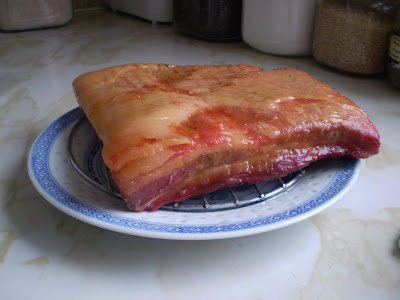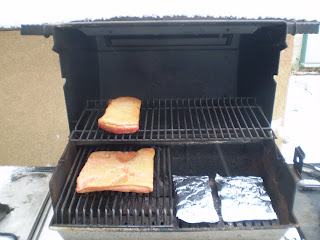The culmination of my autumn preserving was the makin’ of bacon. It never occurred to me that I could cure meat in my own home until I found the blog of one Kevin Kossowan. Just by reading how he categorizes his posts ("Cider Making", "Foraging - Berries", "Foraging - Mushrooms", et c.) you know that you've stumbled across a renaissance foodie. Kevin recommends a book by Michael Ruhlman called Charcuterie with all manner of recipes for cured and smoked meat.
The word “bacon” usually refers to pork belly that has been cured and then smoked. An exception to this rule is “back bacon”, which is cured pork loin. “Canadian bacon” is back bacon that has been cured and then smoked.
Step One: Acquire Pork Belly
I ordered a slab of pork belly from Easyford Meats. The slab was 2.2kg and cost about $25. It was thinner than I expected, only an inch in its thickest parts, and was about one foot by two and a half feet long.
Step Two: Acquire Cure
All the sources I consulted used “pink salt”, which is 6.25% sodium nitrite and 93.75% salt. It is died pink to avoid confusion with table salt and accidental consumption. (Sodium nitrite is toxic in large quantities, but safe in the concentrations used in curing). I went to a butcher supplier called CTR Refrigeration and bought what they call “F.S. Cure”, which is only 5% sodium nitrite. I tweaked the cure recipe so that I had the proper amount of nitrite and plain salt. I also picked up some hickory and cherry wood sawdust while I was there.
Step Three: Cure
I used the basic cure recipe from Charcuterie, which consists of kosher salt, pink salt, and white sugar. I rubbed this mixture onto the surface of my thawed pork belly, which I then set in a shallow plastic tub.
The pork belly sat for almost ten days (longer than the recommended seven). I flipped the slab and redistributed the cure twice over that period. All in all the meat lost much less moisture than I expected: there were only a couple thin puddles of liquid around the belly.
On the tenth day I rinsed the slab under cool water and patted it dry with paper towels. I then placed it on racks, uncovered, in my fridge overnight to form a “pellicle”, a tacky surface that helps the absorption of flavour during smoking. That evening I also put some of my hickory chips in water to soak overnight.
Step Four: Smoke
The next morning I smoked the meat, which was without exaggeration one of the most rewarding food experiences of my life. I made a few aluminum foil packets, each filled with two handfuls of wet hickory chips and one handful of dry. I punched holes in the packets with a fork.
The Result
The biggest difference between homemade and store-bought bacon is texture. My bacon had a denser, coarser, and all in all more satisfying texture than the convenience store variety. The taste was much more robust. I think this is one more grocery store product that has been ruined for me.







Last time I looked, CTR Refrigeration either moved or went out of business. The location on 170 St simple disappeared, as far as I could tell. Another Edmonton pink salt source is the Bosch Kitchen Center. They currently have a white version [sounds lame, I know]. Just a different supplier, as far as I understand.
ReplyDeleteSorry for taking a while to reply - your comment slipped under my radar.
ReplyDeleteThat's too bad about CTR, all my charcuterie "firsts" were supplied by them.
Let's talk curing salt.
Butchers and Packers Supplies, right by Easyford Meats, sells the same "FS Cure" that CTR carried.
The FS Cure from CTR and B&P is only 5% nitrite, whereas the pink salt used in all Ruhlman's recipes is 6.25% nitrite. Using that FS Cure for Ruhlman's recipes has worked fine for slabs of meat like belly, but for brining larger cuts like hocks and hams, the cure has not penetrated to the core of the meat in the allotted time. I think you had a ham post where you mention a problem like that, no?
Which product have you been using? Do you know the exact percentage of nitrite in it?
Another source in Edmonton is Halford's, up by the Yellowhead. They sell Prague Powder, which, according to my research, should by 6.25% nitrite (although it doesn't give a percentage on the label). I bought some recently, but haven't had a chance to test it with a Ruhlman recipe.